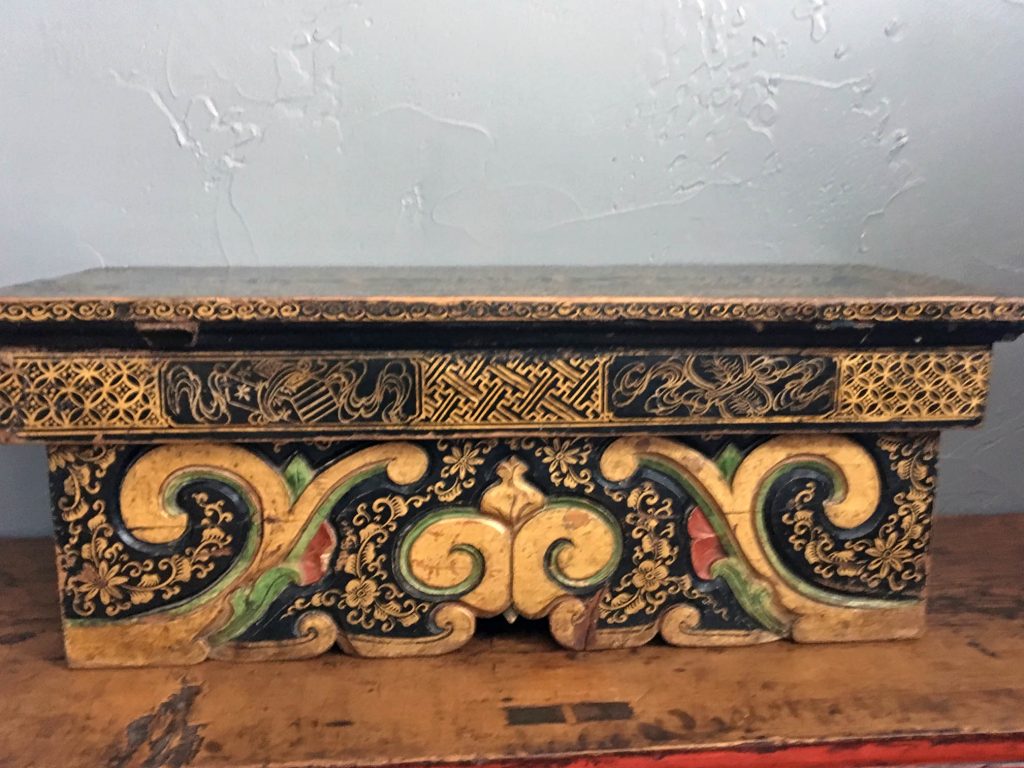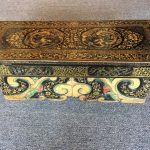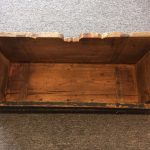
17th/18th century, pine or cypress, mineral colors, gilding. Important as not many “tepchog” survived

Small folding tables (Tepchog) were perhaps one of the earliest of Tibetan furniture. The Tibetans have traditionally been herdsmen, moving from place to place for good pasture for their animals. They normally carry objects in bags made of animal skin, and occasionally various religious items and a small folding table with them so when they stop, they could set up an altar for worship or providing support for their never-ending yak butter tea, sitting on the floor or cushions.
This present small folding table is a classic tepchog, consisting of a solid top and three hinged side panels which allow the table to be folded flat for carrying or for storage. It shows a highly traditional Chinese method of construction usually found on fine hardwood tall tables and chests of the early periods. The three-sided apron below the top board shows dove-tailing corner construction. Underneath the top panel and the elaborately decorated wide front leg panel are tenoned crossbars inset into the wood. Crossbars were usually added to a long table to add strength to the table in order to support a variety of heavy items; it is quite unusual for a small folding table meant to be carried around to be so complexly made.

Generally, the top of a folding table is plain, with the sides usually decorated with carvings or paintings. This table stands out for its top panel with significant motifs and highly gilded paintings. Prominently painted are two sinuous fire-breathing dragons, each in a medallion set among twining flowers and vine. In Tibet, dragons date back at least to the early royal period, from the 7th to the 9th century and represent the Heavenly King. A 4-claws dragon signifies someone in the royal family. This central decoration is framed first by an angular wandering-clouds design, and then by a wide border of magnificently gilded twining floral design. The panel edge is painted with a swirling clouds pattern. Together, these designs mean a wish for heaven to grant health, richness, and good fortune.
Below the top panel the three-sided apron has gilded paintings of four Taohuan designs representing a mixture of what in China is famously known as The Eight Precious Things and The Attributes of a Scholar. In front are The Books (erudition) and The Yarrow (medicinal plant with divinity power); on one side is The Gourd (long life) and on the other side is the Pictoral Scrolls (artistic talent, love of truth). These items are bound by ribbons with ends flying, meaning a wish for their hopes to rise to heaven and be granted. All three legs of this table have relief carvings of the “ruyi” (grant all wishes) motif, which are gold-leaf painted. The richness of work on this tepchog could only mean it was created for someone of high status and not to be casually carried around by some common tribesman.
Antique small folding tables are extremely rare today because they have not survived well due to their being portable so were put in hard and constant use. Also, authentic Tibetan antiques have long been banned from leaving the country, especially one like this tepchog with royal bearing.
